This SoundBlog page was adopted by french visual artist Lara Del Aor on nov. 12, 2008 ... [ ? ]
Dung, dung, dung, beetle, bone, bone, dung, dung
april 14, 2008.
I went to the opening of Jan
Fabre's Ange de la Transformation show, the evening of wednesday
april 9th in the Louvre (thanks to Rob who couldn't make it and passed me
his invitation).
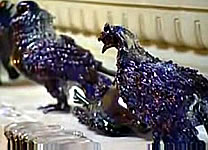 The Angel of Transformation is part of a series of events, in which
this french stronghold of canonized western art invites living
artists to present their work in the context of (part of) its collection.
The Angel of Transformation is part of a series of events, in which
this french stronghold of canonized western art invites living
artists to present their work in the context of (part of) its collection.
Fabre's intervention takes place in the (thirty-nine) galleries devoted
to the painting of the Flemish, Dutch and German schools (in the départment
des Peintures des écoles du Nord), on the second floor of the Richelieu
wing.
I found the result amazing. Spectacle, theater, often thought-provoking; even fun. Among the many guests roaming the galleries that wednesday evening some whispered in flemish of 'great' and 'genius'. Others shook their head in disbelief while I overheard them rather bitterly grumble about 'meaningless' and 'silly' and 'sacrilege', in french. Well, no, not everyone was amused ... (Lynn Barber, reviewing the show for the Guardian sighed: 'Why on earth Jan Fabre?', and referred to the 'Self Portrait' (see below) as 'a miserable little worm' ... [ added june 6th, 2008 ])
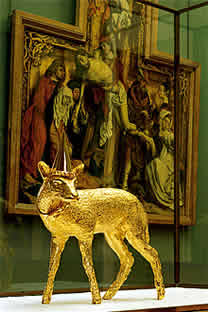 Also
the AGRIF shouted 'sacrilege', the "Alliance Générale contre le
Racisme et pour le respect de l'Identité Française et chrétienne", an organization
of conservative christians that have the unfortunate habit of taking organizers
of artistic events that they consider in one way or another to be 'sacrilegious'
to court. Already before the opening the AGRIF
protested against the show and against the image used for the show's
promotion, in which we see one of the two Sanguis Sum statuettes
(little lambs made from gilded bronze and wearing a pointed party hat) depicted
in front of a painting of the Descent from the Cross by the 'master
of Saint-Barthélémy', equally beautiful. I am myself a grand amateur of
classic 'Descent from the Cross' paintings, and to me it is sort
of obvious why precisely this image was picked for the exhibition's flyers,
banners and posters is. It was the 'safest possible' choice, as the combination
of the 'Descent' with the two delicate gilded lamb-with-party-hat
statuettes, one that is alive, one that's lying dead, each kept in its own
large classic glass showcase, has an evident appeal in its rather traditional
aesthetics. It is touchingly beautiful ... Some will think of Bambi
... (Thank you, God, for sacrilege ..!.. :- )
Also
the AGRIF shouted 'sacrilege', the "Alliance Générale contre le
Racisme et pour le respect de l'Identité Française et chrétienne", an organization
of conservative christians that have the unfortunate habit of taking organizers
of artistic events that they consider in one way or another to be 'sacrilegious'
to court. Already before the opening the AGRIF
protested against the show and against the image used for the show's
promotion, in which we see one of the two Sanguis Sum statuettes
(little lambs made from gilded bronze and wearing a pointed party hat) depicted
in front of a painting of the Descent from the Cross by the 'master
of Saint-Barthélémy', equally beautiful. I am myself a grand amateur of
classic 'Descent from the Cross' paintings, and to me it is sort
of obvious why precisely this image was picked for the exhibition's flyers,
banners and posters is. It was the 'safest possible' choice, as the combination
of the 'Descent' with the two delicate gilded lamb-with-party-hat
statuettes, one that is alive, one that's lying dead, each kept in its own
large classic glass showcase, has an evident appeal in its rather traditional
aesthetics. It is touchingly beautiful ... Some will think of Bambi
... (Thank you, God, for sacrilege ..!.. :- )
We leave Fabre's double as a dwarf-sized wax puppet behind us at the entrance to the galleries, outside, in a pool of blood dripping after his head-on collision with an old master, and enter the immense exposition, only to bump into him time and time again, in many guises, though more often dead than alive.
Every single of the sixty of his works that Fabre distributed over the
thirty nine classic galleries, in one way or other attempts to come to terms
with man's vain struggle in face of imminent death. Nevertheless Fabre's
sculptures and blue ballpoint pen ink drawings appear as surprisingly light
and almost unassuming in the midst of the vast Louvre collection of masterly
visuals conserved and handed down through the ages, many of which of course
depict the inevitable human grief, suffering and death, and almost all of
which are bulging with symbolism and metaphor. 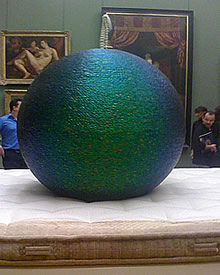 Aside
and along the walls that are the support for this two-dimensional pluri-vocal
mental imagery, Fabre traces a meandering monodic path marked by often transient
and fragile looking, but very physical, 3D objects built from thousands
of iridescent
dung beetle elytra, slices of (human?) bones and angel hair.
Maybe with the sole exception of Le Bousier (Bol van Mestkever,
2001; see picture), an extra-large sphere covered with shining blue, green
and gold beetle wing cases topped with a backbone, and resting on an oversized
stained mattress as a globus cruciger in the palm of a hand, and
which occupies a space that is kept relatively small compared to the sphere-on-mattres's
size, none of the often rather large works actually dominates the room that
it occupies. Partly this is due to the super-human scale in which the contours
and spaces of the former palace and token of French royalty's megalomania
have been drawn. For another part it must be because of the intimidating
riches, abundance and the imposing load of (art's) history that
decorates the walls.
Aside
and along the walls that are the support for this two-dimensional pluri-vocal
mental imagery, Fabre traces a meandering monodic path marked by often transient
and fragile looking, but very physical, 3D objects built from thousands
of iridescent
dung beetle elytra, slices of (human?) bones and angel hair.
Maybe with the sole exception of Le Bousier (Bol van Mestkever,
2001; see picture), an extra-large sphere covered with shining blue, green
and gold beetle wing cases topped with a backbone, and resting on an oversized
stained mattress as a globus cruciger in the palm of a hand, and
which occupies a space that is kept relatively small compared to the sphere-on-mattres's
size, none of the often rather large works actually dominates the room that
it occupies. Partly this is due to the super-human scale in which the contours
and spaces of the former palace and token of French royalty's megalomania
have been drawn. For another part it must be because of the intimidating
riches, abundance and the imposing load of (art's) history that
decorates the walls.
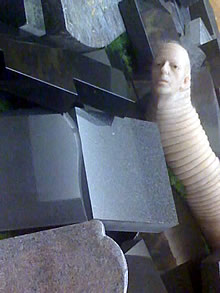 For
the show's pièce de résistance Fabre took about one hundred and
twenty square meters of the floor in the Rubens gallery, dedicated to queen
Marie de Médicis, and made it into a dump for four hundred and seventy granite
tombstones (together weighing over 40 tons). But even this Zelfprotret
als grootste worm van de Wereld ("Self portrait as the biggest worm
of the world", 2008) appears as relatively small and modest when compared
to the size of the room in which it lays. A long pale, fat and hairy worm
with Fabre's head is draped over the tomb stones (see the picture). On many
of the stones the (dutch/flemish) name of an insect and dates are carved.
The insect names and dates refer to writers, thinkers, artists. (Thus, for
example, Marcel Duchamp became the cicada.) Getting nearer, we
hear and see how the worm is breathing heavily. Agonizing. Suffocating.
In between its dying breaths it whispers repeatedly a phrase in dutch: "Ik wil
mijn hoofd uit de strop van de geschiedenis trekken ..." ("I want to
draw my head out of the hangman's rope of history").
For
the show's pièce de résistance Fabre took about one hundred and
twenty square meters of the floor in the Rubens gallery, dedicated to queen
Marie de Médicis, and made it into a dump for four hundred and seventy granite
tombstones (together weighing over 40 tons). But even this Zelfprotret
als grootste worm van de Wereld ("Self portrait as the biggest worm
of the world", 2008) appears as relatively small and modest when compared
to the size of the room in which it lays. A long pale, fat and hairy worm
with Fabre's head is draped over the tomb stones (see the picture). On many
of the stones the (dutch/flemish) name of an insect and dates are carved.
The insect names and dates refer to writers, thinkers, artists. (Thus, for
example, Marcel Duchamp became the cicada.) Getting nearer, we
hear and see how the worm is breathing heavily. Agonizing. Suffocating.
In between its dying breaths it whispers repeatedly a phrase in dutch: "Ik wil
mijn hoofd uit de strop van de geschiedenis trekken ..." ("I want to
draw my head out of the hangman's rope of history").
Together with the glass Doves that shit and rats that fly adorning the Lefuel staircase, the biggest worm is the most 'cartoonish' among the many works that through their persistent monomania succeed in distorting, un-balancing and reframing the weighty symbolism inherent in the oeuvres of the horde of long-dead northern masters that surround them. As far as I am concerned, Fabre should have taken his 'biggest worm' even further. The doll's phrase could have been lip-synched, and I sure would have liked to stumble upon the thing crawling along the floors of the thirty-nine galleries, mingling with the show's visitors, before every once in a while returning to its bed of tombstones ...
Jan Fabre's grand mix - flamboyant, repetitive and obsessive - of body fluids, angels, warriors and beasts, many of which are carnivorous insects, in the Louvre becomes transparent. As it merges with and reflects the sheer endless parade - just as, or maybe even more, flamboyant, repetitive, obsessive - of images of men and gods frozen on the dark and varnished canvasses, it asks to be used as a looking-glass, through which much of its surroundings suddenly appears to become different and far free-er from what it was before.
A bit to my own surprise I found the resulting view to be a deeply optimistic one. Fabre's works in the Louvre radiate pure celebration of life, almost despite themselves.
Jubilant, really.
[ Jan Fabre's The Angel of Transformation at the Louvre, Paris. From april 11th until july 7th, 2008. Search here for details. ]
[ Next related SB-entries: Hirst's skull @ Amsterdam Rijksmuseum | Jeff Koons @ Versailles ]
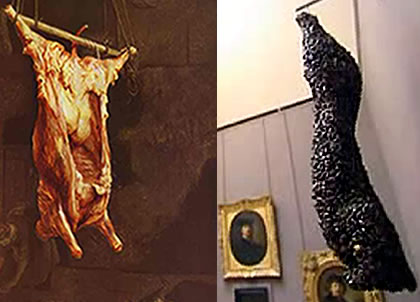
comments for « Dung, dung, dung, beetle, bone, bone, dung, dung » ::
|
Comments are disabled |
[ take me back up ... ]
